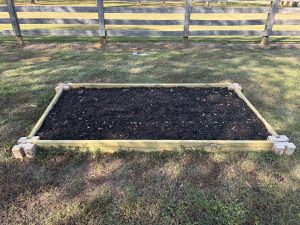When making plans for a fall or spring garden it is important to consider which methods of planting and raising your crops will work best for you. Traditional ground plots can be very effective but like with anything there can be negatives. Issues with space and soil fertility will be your biggest challenges with ground plots. Raised Beds are a very popular choice for several reasons like being aesthetically pleasing, mitigation of poor or no soil, decreases runoff/erosion, positive use of space, and maintenance.
Site Selection – Before creating your raised bed there should be a couple of key factors that are considered. Sunlight is the most important factor. Areas where the raised beds are constructed must have full sun for a minimum of 5 to 6 hours per day for best results. It is ideal to have morning sun do it less intense heat in the morning and dries due off the plant. Staying clear of structures, large trees, tree lines will help to have ample sunlight. Access to a water source close by is imperative for a successful raised bed. Make sure it is placed on well drained level ground away from tree roots that could compete with your crops.
Construction – The most “traditional” raised bed structure are made with wood. Consider pressure treated vs. non-treated wood. Pressure treated wood post 2004 is unlikely to contaminate food crops and will have a longer shelf life. Non-pressure treated will be a less up-front cost but will end up costing more overtime due to having to replace the boards earlier and more often. Screws and nails are appropriate methods to secure the corner but be sure to dispose of them correctly. Concrete corner blocks found at stores like Lowes or Home Depot have become a popular mothed to secure the corners. A 4’x8’ bed is the most popular size due to easy maintenance and construction. To construct this sized bed all you will need is three 2”x6”x8’ boards and four concrete corner blocks. After the outline of the bed has been created, you will need to create a base layer to kill the grass below, so it does not grow up through the soil. You can use materials like cardboard or mulch to accomplish this. The raised beds should be filled with either a mix made for raised beds or a 50-50 mix of compost/organic matter and topsoil. 1 cubic yard of material will fill a 4’x8’ raised bed.
Raised beds can be an effective and fun way to garden at home. Consider all factors discussed to make sure your raised beds are successful. For more information on raised beds contact your local UF/IFAS Extension Office. 
- Why Raised Beds? - November 5, 2025
- Landscape Tree Protection - September 11, 2025
- Weed Control Methods in Landscapes and Gardens - June 20, 2025

